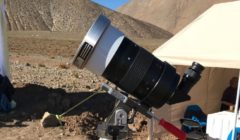- travelArt team during eclipse
- Eclipse
- Partial Eclipse
- Eclipse in the North of Chile
- Eclipse in Chile
- Total Eclipse
Chile recently experienced a solar eclipse when the moon moved between the Earth and the sun on July 2, 2019. This year the eyes of the world were on Chile as a total solar eclipse occurred in the northern region of Coquimbo and in the southern part of the Atacama region. The duration of the total phase was about 2.5 minutes.
A total solar eclipse has occurred only three times in this region in the last 500 years, the first time in 1592 and the last in 1893. This year’s eclipse was celebrated by locals and the approximately 300,000 tourists who travelled to the aforementioned regions. By the end of May, 80% of accommodations were already occupied, according to a survey by the regional chamber of tourism.
If you want to learn more about astronomy and the observatories in Chile, you can download the free app “Chile Mobile Observatory”, an initiative of the foundation “Imagen de Chile”. The app was developed especially for this year’s astronomical phenomenon and provides not only information about the solar eclipse but also some of the best images of the universe taken by Chile’s observatories. The app is available in Spanish and English. With this app, “Imagen de Chile” would like to bring Chile’s astronomical development to the hands of national and international users. The CEO of “Imagen de Chile”, Constanza Cea, highlighted that “thanks to the eclipse, the eyes of the world will be on Chile this year”. The development of astronomy is becoming more and more important, and Chile, with its 40 international observatories, is at the forefront.
Space phenomena are increasingly associated with Chile, home to some of the largest and best observatories in the world. Next year Chile will again be the best place on earth to enjoy the total solar eclipse on December 14, 2020 – this time in the central and southern part of Chile.
If you would like to experience the eclipse in Chile next year, book your trip in advance. For more information, please write to info@travelart.com or contact your travelArt representative.







